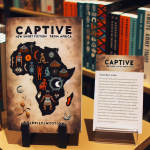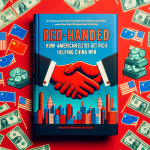As an Amazon Associate I earn from qualifying purchases.
Unveiling ‘AI Superpowers': Navigating the New World Order Between China and Silicon Valley
Artificial Intelligence is not just a technological advancement; it is a seismic force reshaping global power structures, economies, and societies. In “AI Superpowers: China, Silicon Valley, and the New World Order,” author Kai-Fu Lee brings unparalleled insights into the escalating competition between China and the United States, revealing how the race for AI supremacy is setting the stage for a new geopolitical rivalry. If you're eager to understand the dynamics governing our AI-driven future, this book delivers a compelling and thought-provoking narrative.
Drawing upon his extensive experience in both Eastern and Western tech ecosystems, Kai-Fu Lee masterfully narrows down the key elements driving innovation in AI. China's assertive state-driven approach contrasts sharply with Silicon Valley's entrepreneurial freedom, posing significant questions about the ethical, economic, and social implications of these two diverging paths. The book not only highlights the exceptional strides made by companies on either side of the Pacific but also provides a critical analysis of the looming challenges this global AI race entails. From national security concerns to labor displacement and ethical dilemmas, “AI Superpowers” offers readers a comprehensive lens through which to view the strategic moves being made by tech giants and governments alike.
Plot
“AI Superpowers: China, Silicon Valley, and the New World Order” by Kai-Fu Lee delves into the ongoing global race for AI dominance, primarily focused on China and the United States. The book posits that we are entering an era where Artificial Intelligence will reshape economies, employment landscapes, and global power dynamics. Through meticulous comparisons and a blend of historical insights, Lee highlights how China, with its unique combination of government support, abundant data, and entrepreneurial zeal, is poised to challenge and possibly surpass the U.S. in AI development.
Characters
Although “AI Superpowers” is a non-fiction book, Kai-Fu Lee personalizes his narrative by sharing his own professional journey and experiences within the tech industry. As a key player in both Silicon Valley and China's tech scene, Lee brings authenticity and a compelling perspective to the discussion. Additionally, the book features various industry titans and thought leaders from both regions, like Chinese executives from companies such as Baidu, Alibaba, and Tencent, and their counterparts in American tech giants like Google, Apple, and Facebook.
Writing Style
Kai-Fu Lee's writing style is both engaging and accessible. He skillfully balances technical explanations with anecdotal experiences, making complex AI concepts understandable for readers without a technological background. His narrative is well-organized, structured around thematic chapters that progressively build upon each other to provide a comprehensive overview of the current AI landscape. Lee's passion for AI and deep knowledge of both Western and Eastern tech ecosystems shine through clearly in his writing.
Setting
The setting of “AI Superpowers” transcends geographical boundaries, focusing on two primary arenas: Silicon Valley in the United States and the bustling tech hubs of China, such as Beijing and Shenzhen. These settings are not just physical locations but represent two different philosophies and approaches to AI development. Silicon Valley is depicted as the birthplace of innovation, fueled by its strong research institutions and innovative culture, while China is described as an ecosystem driven by scale, speed, and practical applications, supported by the government and vast amounts of data.
Unique Aspects
One of the unique aspects of “AI Superpowers” is its balanced perspective on the strengths and weaknesses of both China and Silicon Valley. Lee does not merely present a one-sided argument but rather provides a nuanced discussion on how each region can learn from the other. Additionally, the book highlights ethical and societal considerations in AI development, urging for a mindful implementation of AI technologies. Lee also introduces the concept of the “Four Waves of AI,” which encapsulates different phases of AI adoption and maturity, adding a layered depth to the reader's understanding of AI progress.
Economic Impact
AI Superpowers: China, Silicon Valley, and the New World Order” discusses the seismic impact AI will have on the global economy. Citing various economic models and case studies, Kai-Fu Lee illustrates how AI applications in sectors such as healthcare, finance, and manufacturing will lead to increased efficiency and economic productivity. However, Lee also warns of the potential for economic disparity, as countries and companies at the forefront of AI could leverage their technological advantage to create monopolies, further widening the gap between rich and poor nations.
Technological Advancements
Lee discusses groundbreaking advancements in AI technologies, including facial recognition, autonomous vehicles, and natural language processing. He provides examples from both China and Silicon Valley to illustrate how rapid innovation cycles are pushing the boundaries of what AI can achieve. For instance, Chinese companies have made significant strides in implementing AI for everyday uses—from smart city infrastructure to advanced surveillance systems, showcasing a fast-paced application of AI in public and private sectors.
Regulatory Framework
The book tackles the varying regulatory landscapes in China and the U.S. and how these frameworks impact AI development. Lee explains that China's top-down approach allows for rapid deployment and scaling of AI technologies, often without the bureaucratic hurdles found in Western countries. Conversely, the U.S. model, while slower in terms of regulatory approval, benefits from a more transparent and democratic process. This dichotomy presents a fascinating backdrop against which the AI race unfolds, highlighting both the advantages and drawbacks of each regulatory approach.
Ethical Considerations
Kai-Fu Lee does not shy away from discussing the ethical implications of AI. He raises crucial questions about privacy, job displacement, and the potential for AI to exacerbate societal biases. As AI technologies become more ingrained in daily life, the ethical frameworks governing their use will become increasingly important. Lee suggests that ethical AI will require global cooperation and emphasizes the necessity for an international dialogue to establish norms and standards that ensure AI benefits humanity as a whole.
Cultural Influences
“AI Superpowers” explores how cultural factors influence AI development in China and the U.S. Lee describes how the collectivist culture in China, emphasizing rapid execution and societal harmony, contrasts with the individualistic and often idealistic Silicon Valley culture that prizes innovation and disruption. These cultural nuances play a critical role in shaping the strategies and trajectories of AI development in these two regions, offering readers a deeper understanding of the underlying motivations and challenges each faces.
Pros
Insightful Perspectives
The book provides a deep dive into the contrasting strategies and methodologies of AI development in China and Silicon Valley. This comparative analysis offers readers an enriched understanding of the global AI landscape, making it easier for users to grasp the nuances between different technological ecosystems. This thorough examination adds a layer of depth, enhancing the educational value for the audience.
Expert Author
Kai-Fu Lee's extensive experience in the tech industry lends significant credibility to his assessments and predictions. His background allows him to offer well-informed insights and reliable information, making the book a trustworthy source. The reader's experience is vastly improved by knowing they are engaging with content produced by an expert in the field.
Real-world Examples
The use of concrete examples and case studies strengthens the book's arguments and makes complex ideas more accessible. By grounding abstract concepts in real-world scenarios, the author enables readers to understand the practical implications of AI technologies. This contextualization enhances comprehension, allowing users to relate theoretical knowledge to actual events and practices.
Futuristic Outlook
The book’s forward-looking approach captivates readers who are interested in what lies ahead. It not only discusses the current state but also explores potential future developments in AI, stirring curiosity and engagement. This speculative aspect keeps users engaged, as they ponder the possible directions that AI could take in the years to come.
Cons
Western Bias
While the book tries to maintain an objective stance, there are instances where Western perspectives are more prominently featured. This can create a somewhat unbalanced view, making the reader question the impartiality of the analysis. Such bias can distort the user experience by skewing perceptions of global AI dynamics, potentially leading to an incomplete understanding.
Complex Language
The use of technical jargon and deep industry terms may alienate readers who are not well-versed in AI or technology. This complex language can hinder readability and comprehension, making it difficult for a broader audience to fully engage with the material. Users may find it challenging to keep up, which detracts from the overall accessibility of the book.
Limited Focus on Ethical Concerns
The book could benefit from a more comprehensive discussion on the ethical implications of AI. While it touches on these issues, the focus is not as robust as some readers might expect. This lack of emphasis on ethics may leave users wanting more in terms of understanding the moral and societal ramifications of AI advancements.
Repetitive Arguments
Certain arguments and points are revisited multiple times throughout the book, potentially leading to a sense of redundancy. This repetition can make the reading experience feel monotonous, diminishing the book's overall impact. Users might find themselves skimming through sections that reiterate previously discussed content, detracting from sustained engagement.
FAQ
What is the primary focus of “AI Superpowers: China, Silicon Valley, and the New World Order”?
The book primarily focuses on the state of artificial intelligence (AI) development and its potential impact on the global economic and political landscape. It compares AI advancements in China and Silicon Valley, examining the competitive dynamics between the two regions.
Who is the author of the book?
The book is authored by Kai-Fu Lee, a prominent AI expert, venture capitalist, and former executive at major tech firms like Google China and Microsoft.
Why should I read this book?
“AI Superpowers” offers a comprehensive analysis of the AI arms race, particularly the competition between the United States and China. It provides insights into how AI could reshape jobs, industries, and the geopolitical order, making it essential reading for those interested in technology, economics, and global affairs.
Does the book focus more on technical AI concepts or on its societal impacts?
While it covers some technical aspects to provide context, the book focuses more on the societal, economic, and geopolitical impacts of AI. It is written for a general audience, not just for those with a technical background.
What are the strengths of this book according to reviews?
Reviews often highlight Kai-Fu Lee’s unique perspective, given his background and experience in both the U.S. and Chinese tech industries. The book is praised for its in-depth analysis, clear writing, and the balanced discussion of potential future scenarios involving AI.
Does the book suggest any particular policies or strategies for dealing with the rise of AI?
Yes, Kai-Fu Lee offers several recommendations for policymakers, businesses, and individuals to adapt to the forthcoming changes brought about by AI. These include investing in education and training for AI-related skills, fostering innovation, and creating robust economic policies to manage disruptions in the job market.
How does the book compare the AI capabilities of China and Silicon Valley?
The book explains that while Silicon Valley has been a leader in cutting-edge AI research, China has rapidly scaled up its capabilities through data accumulation, implementation speed, and supportive government policies. It discusses how these different strengths could influence the future competitive balance between the two regions.
Is the book optimistic or pessimistic about the future impact of AI?
The book presents a balanced view, acknowledging both the incredible opportunities that AI could bring as well as the significant challenges it poses. Kai-Fu Lee is cautiously optimistic but stresses the need for proactive measures to mitigate risks.
What type of reader would benefit most from this book?
“AI Superpowers” is suitable for anyone interested in the future of technology and its broader implications. This includes business leaders, policymakers, students, and general readers interested in understanding the global AI landscape.
Are there any real-world examples or case studies in the book?
Yes, the book includes numerous real-world examples and case studies to illustrate the current state and potential future of AI. These examples help ground the theoretical discussions in practical, tangible scenarios.
What criticisms have been made about the book from reviewers?
Some criticisms include a perceived bias towards China due to the author’s background, occasional repetition of key points, and the lack of detailed technical content for those seeking a deep dive into AI technologies. However, these points are generally overshadowed by the book’s insightful analysis and engaging narrative.
In conclusion, “AI Superpowers: China, Silicon Valley, and the New World Order” by Kai-Fu Lee stands out as an invaluable resource for anyone interested in understanding the seismic shifts occurring in the technology landscape today. Lee, a renowned AI expert with years of experience in both Eastern and Western technology ecosystems, uniquely positions himself to offer a comprehensive and nuanced analysis that is both insightful and accessible.
One of the major draws of this book is its focus on the parallel AI development tracks in China and the United States. Lee meticulously outlines the novel approaches and strategies adopted by tech giants in both nations, offering readers a close-up view of how these strategies are shaping global technology trends. He delves into the competitive advantages each country holds, be it China's “copycat” culture turning intensely innovative or Silicon Valley's venture capital-driven environment. By presenting these contrasting yet complementary narratives, the book equips readers with a global perspective on AI advancements, making it a vital read for business leaders, policymakers, and tech enthusiasts alike.
Moreover, “AI Superpowers” excels in demystifying complex AI concepts, transforming them into digestible, real-world scenarios. Lee's ability to translate technical jargon into layman's terms makes the book accessible to a broad audience. He offers plenty of real-world examples, case studies, and personal anecdotes that render the intricate world of AI tangible and relatable. This not only aids in understanding but also in appreciating the profound implications AI has on various sectors including healthcare, education, and employment.
One of the most valuable insights from the book is its exploration of the implications of AI on the future workforce. Lee doesn't shy away from discussing the intrinsic challenges posed by AI, such as job displacement and ethical concerns, along with the incredible opportunities for innovation and enhanced productivity. His balanced viewpoint encourages a critical yet optimistic outlook, pushing readers to consider how to best prepare for an AI-driven world.
In summary, “AI Superpowers” is an enriching read that provides a well-rounded understanding of the current and future AI landscape. With its thorough analysis, forward-thinking insights, and practical implications, the book serves as an essential guide for navigating the increasingly complex world of artificial intelligence. Whether you're a tech veteran or a newcomer to the field, Kai-Fu Lee's work offers clarity, depth, and foresight, making it a must-read in the era of AI.
Amazon and the Amazon logo are trademarks of Amazon.com, Inc, or its affiliates.





















































